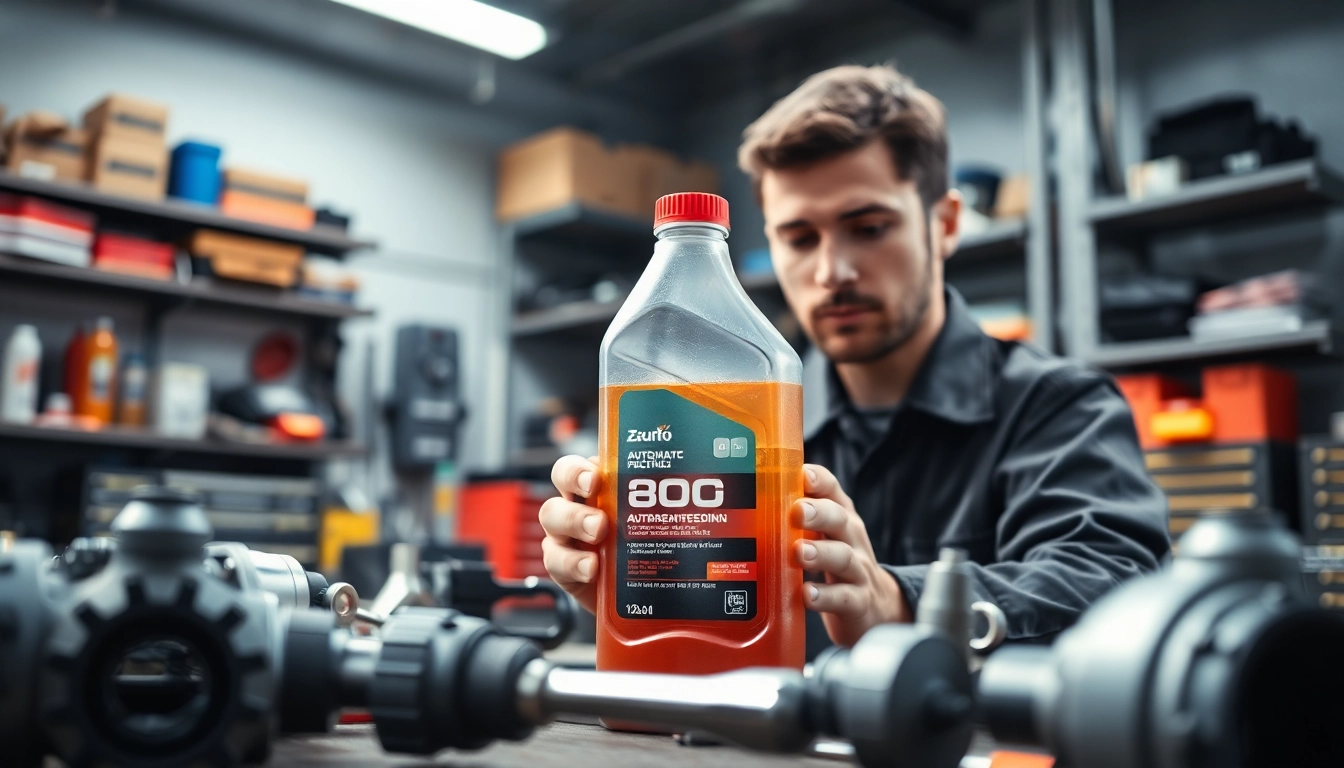Introduction to Automatic Transmission Fluid
In the world of automotive maintenance, understanding automatic transmission fluid (ATF) is essential for ensuring the longevity and performance of your vehicle’s transmission system. The transmission plays a crucial role in a car’s functionality, and the fluid that lubricates and powers this vital system is just as important. In this comprehensive guide, we will delve deep into the nature of automatic transmission fluid, its types, maintenance practices, and offers insights into recognizing issues before they escalate into serious problems.
What is Automatic Transmission Fluid?
Automatic transmission fluid is a specialized lubricant designed for the automatic transmission of vehicles. It serves multiple purposes beyond mere lubrication, including:
- Cooling the transmission components
- Acting as a hydraulic fluid to facilitate gear changes
- Cleaning internal parts and preventing corrosion
- Providing frictional properties required for efficient power transfer
Why is Automatic Transmission Fluid Important?
The importance of automatic transmission fluid cannot be overstated. It helps to keep the transmission system in optimal condition, ensuring smooth gear shifts and extending the life of the transmission. If the fluid levels drop or if the fluid becomes contaminated, it can lead to serious issues, including:
- Slipping gears
- Delayed shifting
- Overheating of transmission components
- Increased wear and tear
Regular maintenance and timely fluid changes are essential to avoid these issues and maintain vehicle performance.
Common Myths About Automatic Transmission Fluid
Several myths surrounding automatic transmission fluid can lead to misunderstandings about its use and maintenance:
- Myth 1: Automatic transmission fluid lasts the lifetime of the vehicle.
Reality: Most manufacturers recommend changing it at regular intervals to preserve transmission health. - Myth 2: All ATFs are the same.
Reality: Different vehicles require specific types of transmission fluid, known as OEM specifications. - Myth 3: Only a mechanic can change the transmission fluid.
Reality: While a mechanic can perform the task, with the right tools, knowledgeable vehicle owners can do it themselves.
Types of Automatic Transmission Fluid
Conventional vs. Synthetic Automatic Transmission Fluid
Automatic transmission fluids can be categorized into two main types: conventional and synthetic.
- Conventional ATF: Made from refined crude oil, conventional ATFs contain additives that improve performance and longevity. They are often less expensive, but may not offer the same level of protection as synthetic fluids.
- Synthetic ATF: These fluids are engineered in laboratories with superior, tailored properties. They provide better high-temperature stability, resistance to oxidation, and overall improved performance, especially in extreme driving conditions. Synthetic ATFs tend to last longer and can lead to better fuel efficiency.
Automatic Transmission Fluid for Specific Vehicle Brands
Many manufacturers have developed their own formulations of ATF. Here are some examples:
- Dexron: Used mainly in General Motors vehicles.
- Mercon: Ford vehicles typically require this type.
- ATF+4: A fluid developed for Chrysler transmissions.
- WS ATF: Toyota’s specific fluid for its vehicles, ensuring compatibility and performance.
It’s crucial to use the fluid specified in your vehicle’s owner manual to ensure compatibility and optimal performance.
Choosing the Right Automatic Transmission Fluid
Selecting the correct ATF involves several considerations:
- Consult your owner’s manual for manufacturer specifications.
- Consider the type of driving you do (towing, commuting, etc.).
- Choose between conventional or synthetic based on budget and performance needs.
Using the wrong type of transmission fluid can lead to issues, so it’s essential to make this selection carefully.
How to Change Automatic Transmission Fluid
Step-by-Step Guide to Fluid Replacement
Changing your vehicle’s automatic transmission fluid is a straightforward process. Here’s a step-by-step guide:
- Gather Your Tools: You’ll need a wrench set, a funnel, a drain pan, and the appropriate ATF.
- Locate the Drain Plug: Most vehicles have a drain plug located on the transmission oil pan.
- Drain Old Fluid: Remove the plug and allow the old fluid to drain completely into the pan.
- Replace the Filter: If your vehicle has a transmission filter, now is the time to replace it.
- Fill with New ATF: Using a funnel, fill the transmission with the new fluid. Check your owner’s manual for the correct capacity.
- Check Fluid Level: Start the engine and let it warm up. Check the fluid level, adding more if necessary.
- Dispose of Old Fluid: Properly dispose of the old fluid at a recycling center or auto parts store.
Tools and Equipment Needed for the Change
To perform a successful transmission fluid change, ensure you have the following items:
- A catch pan for draining old fluid
- A funnel for pouring new fluid
- Rags for cleaning up spills
- A socket set and ratchet
- Transmission filter (if required by your vehicle)
- New ATF (ensure it matches manufacturer specifications)
Safety Precautions and Best Practices
Performing a transmission fluid change can be safe if you adhere to certain precautions:
- Ensure the vehicle is parked on a level surface and the engine is cool.
- Wear gloves and protective eyewear to prevent contact with fluid.
- Follow proper disposal methods for waste fluids and materials.
- Consult your owner’s manual for specific guidance relevant to your vehicle.
Signs of Low or Contaminated Automatic Transmission Fluid
Symptoms Indicating a Fluid Change is Needed
Recognizing the signs of low or contaminated ATF can save your vehicle from significant damage:
- Delayed gear engagement when shifting from park to drive or reverse.
- Unusual noises like grinding or whining when the vehicle is in gear.
- Burning smell from the transmission area indicating overheating.
Testing Automatic Transmission Fluid Quality
To ensure the fluid is still functional, you can conduct a simple quality check:
- Color Test: Healthy ATF should be a clear red color. If it appears brown or has a burnt smell, it’s time for a change.
- Viscosity Check: Rub some fluid between your fingers; it should feel smooth and slippery. Gritty or dirty fluid indicates contamination.
When to Seek Professional Help
While many processes can be handled at home, certain situations demand professional assistance:
- If you’re unsure of the fluid type your vehicle requires.
- If you experience severe transmission symptoms, such as total failure or slippage.
- If you’re uncomfortable handling vehicle maintenance tasks.
Professional mechanics can provide diagnostic services that may catch underlying problems that are not readily noticeable.
Conclusion and Recommendations for Automatic Transmission Fluid
Best Brands of Automatic Transmission Fluid
Some of the most reputable brands for hydraulic transmission fluids include:
- Valvoline: Known for its high-quality synthetic formulations that cater to a variety of vehicles.
- AmsOil: Offers specialized products, particularly for high-performance transmissions.
- Mobil 1: Renowned for its synthetic ATFs that provide excellent protection and longevity.
- Castrol: Offers a wide range of ATF that provides enhanced performance across different applications.
Maintenance Tips for Longevity
To extend the life of your automatic transmission fluid, consider the following best practices:
- Check fluid levels regularly as part of your routine maintenance.
- Change the fluid as recommended by your vehicle manufacturer, typically every 30,000 to 60,000 miles.
- Monitor for leaks and repair them promptly.
- Use quality transmission fluid that meets OEM specifications.
Final Thoughts on Automatic Transmission Fluid Care
Caring for your automatic transmission fluid is an essential part of vehicle maintenance that can result in significant long-term benefits. By understanding its importance, knowing how to choose the right type, and being aware of the signs of trouble, you’ll be better equipped to protect your vehicle and ensure it performs optimally for years to come. Remember that when in doubt, consulting a professional can provide peace of mind and ensure your vehicle stays in top condition.



